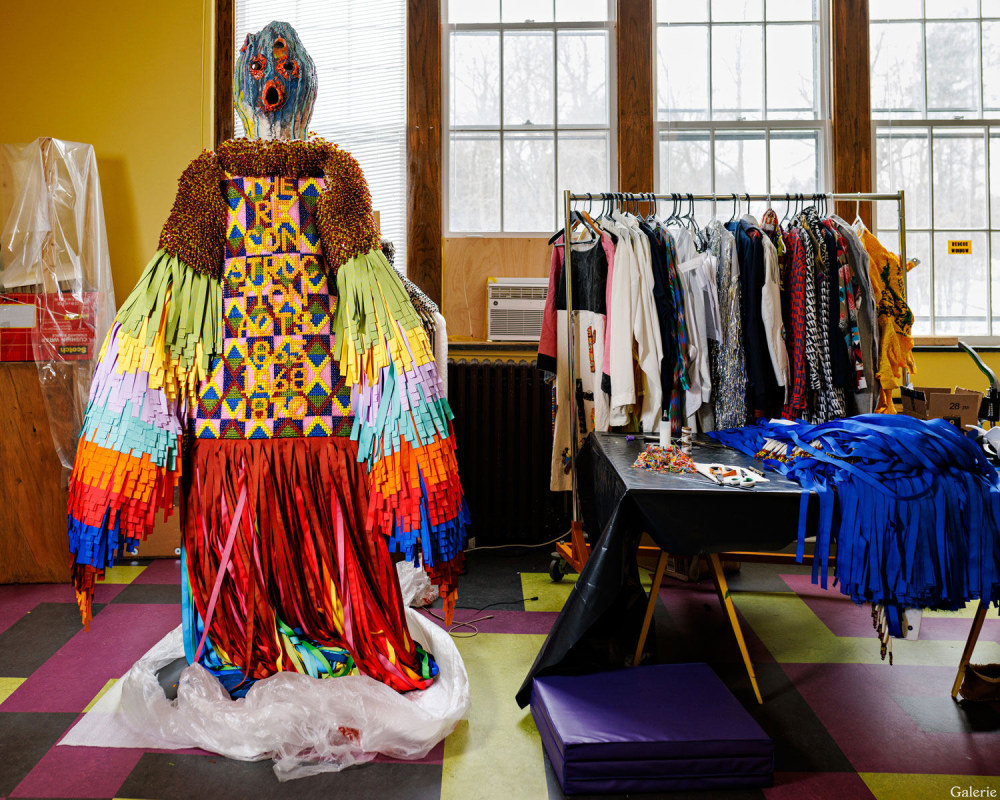

By Ted Loos
The selection of Jeffrey Gibson to represent the U.S. at this year’s Venice Biennale was historic. The artist, whose ancestry includes Choctaw and Cherokee forebears, is the first Indigenous American to receive the honor of a solo show in the U.S. pavilion at the world’s most prestigious exhibition, which opened in April and is on view through November.
Given the increased visibility for Native American artists in museums of late, it seemed like perfect timing for Gibson, whose multimedia practice often combines Native craft with dazzling color and dynamic geometries, fusing cultural identity and personal history with contemporary art savvy. Arguably his best-known works are the hanging punching bags that he covers in spirited beading, frequently incorporating poignant quotes and slogans taken from literary, political, and pop culture sources.
When Gibson got the call that he had been picked for the biennial, he was driving and had to pull to the side of the road. “I started crying,” he recounts from his studio inside a former school near Hudson, New York, where he and a team of a dozen assistants have been busy creating an ambitious group of more than 20 works for the event. “I knew that if I was going to do Venice, I wanted to take it up a notch.”
Gibson has done just that. He conceived the exhibition in consultation with three pavilion commissioners: Kathleen Ash-Milby, a curator of Native American art at the Portland Art Museum in Oregon and a member of the Navajo Nation; Louis Grachos, the Phillips executive director of SITE Santa Fe; and Abigail Winograd, an independent curator.
The presentation spans a variety of media, reflecting Gibson’s many talents. Wall murals, flags, and paintings on both paper and canvas mix with sculptures, some of which are striking busts that are beaded and adorned with buttons, tin jingles, and other materials. There is also a video, She Never Dances Alone, from 2020, the only work not specifically made for the show.
Ash-Milby, a longtime friend and colleague of Gibson’s, has seen the fortunes of Indigenous artists slowly rise over the decades. “We have these superstars now who are taking off in their careers,” she says.
Gibson may be a star, but he has not lost the sense of purpose that is reflected in his art’s messaging. Texts emblazoned on wall hangings and punching bags include quotes from Frederick Douglass, Booker T. Washington, and George Washington, as well as amendments to the Constitution and equal rights laws. One punching bag bears the words We Hold These Truths to Be Self-Evident.
“There have been voices from the beginning seeking and demanding justice and equity,” Gibson says. “I wanted to walk through history and to show that these thoughts that might be considered progressive now, they’ve actually been around for a long time.” The problem, he adds, is that “some things that have been passed just haven’t been enacted or enforced.”
There’s no shortage of visual delight in Gibson’s art, thanks in part to his unabashed love of color. Paintings such as The Right of the People Peaceably to Assemble feature arresting geometric patterns rendered in pulsating chromatic arrays, including vivid neon hues.
Red has always been a particular favorite of the artist, and in the pavilion’s forecourt he has installed an all-red outdoor sculpture composed of variously sized classic plinths that are arranged like geological formations and can be used as seating. “Indigenous people have been referred to as ‘red’ for all these years,” Gibson says. “And for Native people, it also represents everyone’s blood.”
Winograd, who worked with Gibson on a 2021 Chicago show of MacArthur Foundation “genius grant” winners, notes his ability to synthesize. “Obviously, Jeffrey’s work is in conversation with Native aesthetics,” she says. “But you can’t talk about his practice without talking about Andy Warhol and Pop, about the pattern and decoration movement, and Op Art.”
Gibson has found a way to harness and transform his many layers of outsiderness. Identifying as queer and gay, he is married to Norwegian artist Rune Olsen. Gibson, who lives near the studio, grew up partly in Germany and South Korea, the son of a civil engineer. “It’s given me a perspective,” he says of living elsewhere. “I’ve grown up understanding this incredible challenge of the premise of America.”
Although it makes Gibson slightly uncomfortable to have the limelight of the Venice Biennale shining on him, he sees the experience as part of necessary progress. As he puts it, “I feel I’ve been given opportunities to do things that will continue to resonate in ways that I have no control over in the next decades.”
Photo by Axel Dupeux